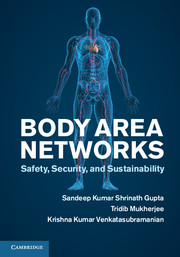Book contents
2 - Body area networks
Published online by Cambridge University Press: 05 April 2013
Summary
A body area network (BAN) is a network consisting of a heterogeneous set of nodes that can sense, actuate, compute, and communicate with each other through a multihop wireless channel. A BAN collects, processes, and stores physiological (such as electrocardiogram (ECG) and blood pressure), activity (such as walking, running, and sleeping), and environmental (such as ambient temperature, humidity, and presence of allergens) parameters from the host's body and its immediate surroundings; and can even actuate treatment (such as drug delivery), on the basis of the data collected. BANs can be very useful in assisting medical professionals to make informed decisions about the course of the patient's treatment by providing them with continuous information about the patient's condition.
BANs belong to a much more generic class of device networks called wireless sensor networks (WSNs) [27]. BANs evolved from WSNs through a series of intermediate steps whereby first the WSN concept was applied to personal devices such as laptops, phones, cameras, and printers. Such networks are called personal area networks (PANs) [28], or wireless PANs (WPANs) [28]. From WPANs evolved BANs in which medical devices, such as pulse oximeters, and personal computing or auxiliary devices such as smart phones and retina prostheses [29, 30] were networked through the wireless channel and worn on the body. Devices were also implanted, such as pacemakers, which communicate through the body to an outside controller. In a hospital setting, BANs are networked with other in-hospital medical devices such as Holter monitors and medical data recorders to form medical device networks (MDNs) [31] for post-operative or intensive-care-unit (ICU) patient monitoring.
- Type
- Chapter
- Information
- Body Area NetworksSafety, Security, and Sustainability, pp. 9 - 25Publisher: Cambridge University PressPrint publication year: 2013

